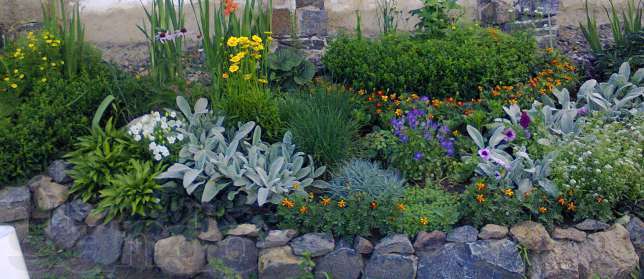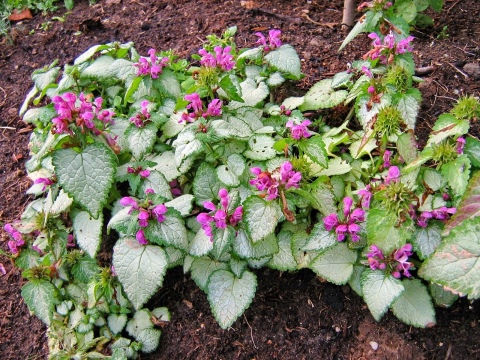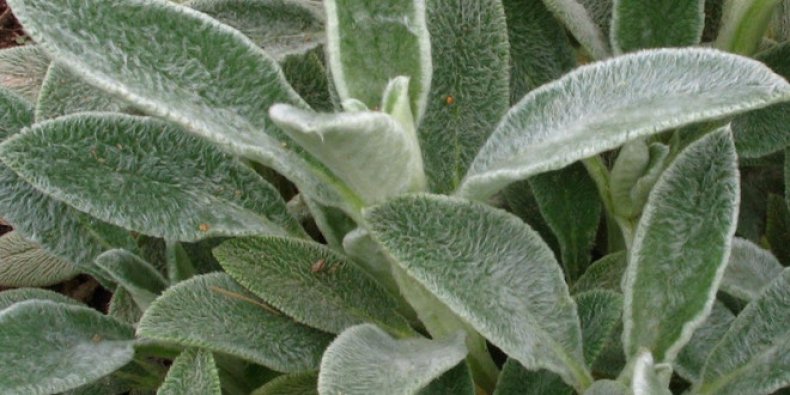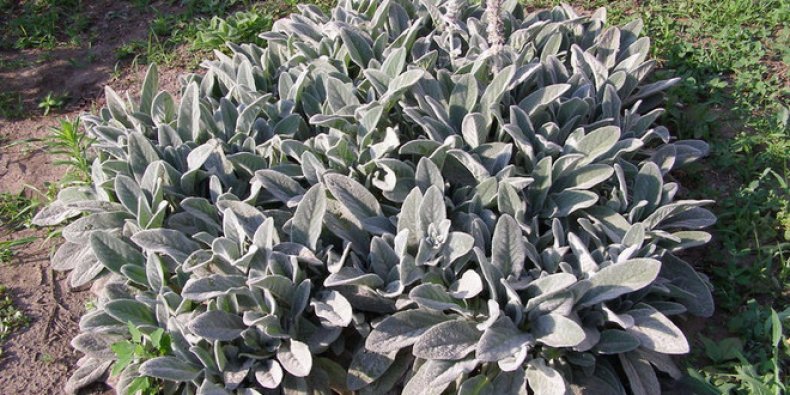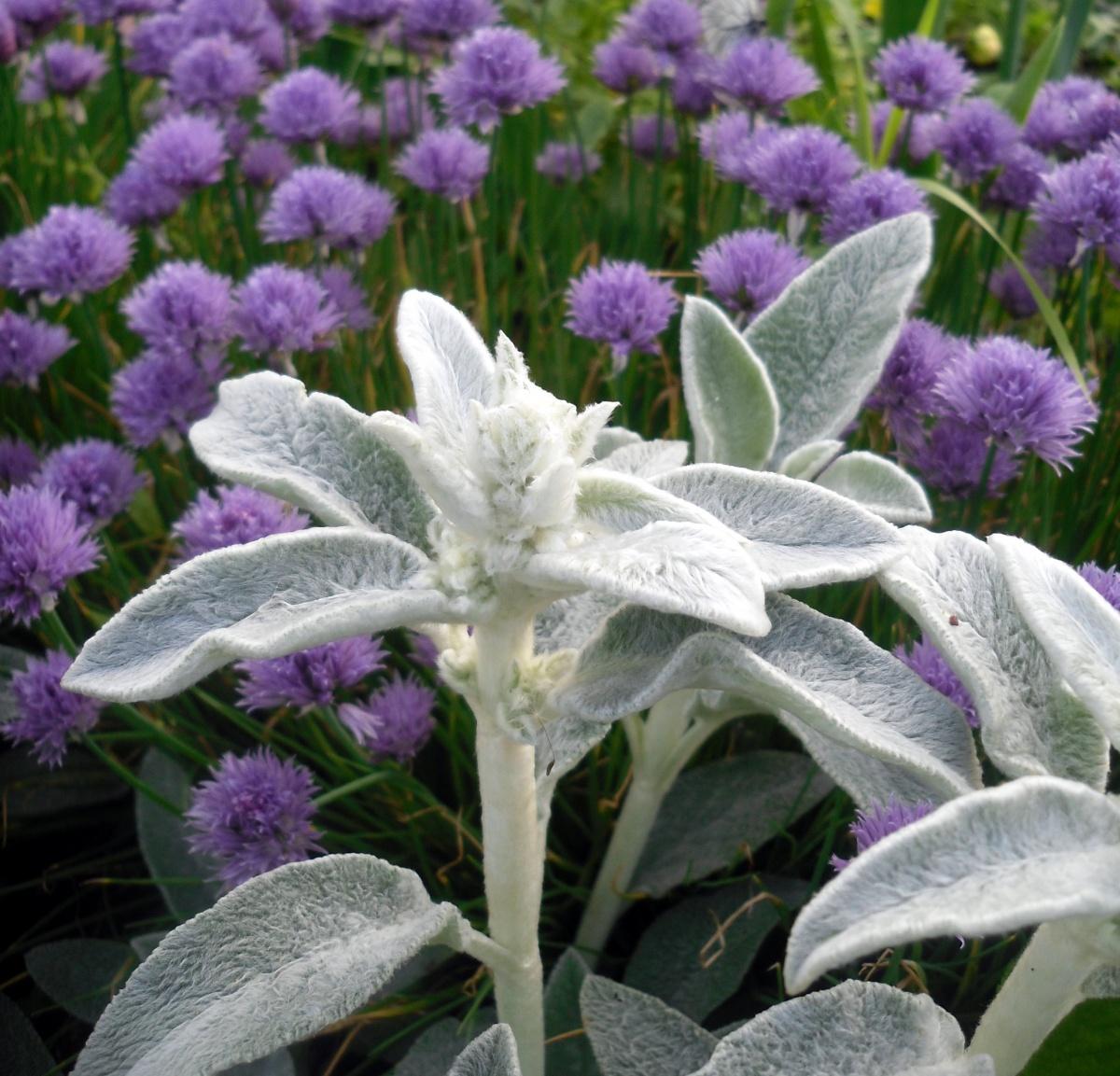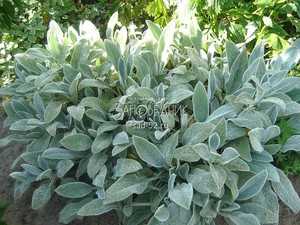Woolly sheep ears Growing from seeds Planting and care Photo in landscape design
Woolly chisel, sheep's ears or woolly stachis (Latin Stachys byzantina) is a perennial herb 20-60 cm high from the Yasnotkovye family. Oblong leaves with tomentose pubescence, which you just want to stroke, sit oppositely on erect stems. Due to its interesting appearance, the popular name of stakhis is used - sheep ears. The dark green shade of the leaves emphasizes the white-silvery pubescence. Stems are erect and branching.
Woolly Stachis blooms throughout May-August. Whorls of pretty pink flowers form a spike-shaped inflorescence. The leaves are very attractive to flower growers and in most cases the inflorescences are plucked before blooming. Already in the first year, a lawn will form, and in the next season, an almost solid rug will turn out.
In the wild, the Byzantine purse is found in Iran, Armenia, Turkey, in the Caucasus, in the Black Sea region.
Sheep ears are propagated by seeds and vegetatively (dividing a bush, cuttings).
Popular varieties
A variety of varieties is a distinctive feature of the "overseas" guest. Several popular types stand out on the flower beds of Russian florists:
- Silver Carpet. The leaves are tightly pressed against each other, the stems creep along the ground, there are few peduncles, and the decorative properties are high. Small bushes look beautiful, lined up along the paths.
- Striped Phantom. Perennial 35-40 cm high, in a group planting forms a single decorative cover. Leaves are fleshy, elliptical in shape. The color of the plate is green with cream stripes. Throws out an ear - thick at the top, thinned at the base.
- Sheila Macqueen. Non-flowering ground cover variety. Compact bushes up to 15 cm tall act as a beautiful backdrop for other flowers.
- Big Ears. Shoots stretch 25 cm in height, the color of soft leaves is muted green.
- Helene Von Stein. Frost-resistant plant (you need to cover it in the first year after planting) up to 65 cm high. Grows in sunny areas, but tolerates partial shade well. A dense ear consists of lilac flowers.
- Cleaner Monier. Medium-sized perennial shrub 45-60 cm high with green leaves. The stem is straight or slightly curved, the flowers are purple-pink. Blooms in June-July. Usage - borders, flower beds.
- One-year field scrub. Differs in branched rough leaves. It grows up to 15 cm. The lower leaves are cordate, the upper ones are ovoid. The flowers on the corolla are at first single, to the apex - trifoliate pink. Prefers sandy soils.
- Stachys officinali officinalis. Unusual appearance in height - it reaches 100 cm. Stems are tetrahedral, there are few leaves, but they are long - 10-12 cm. The plates are covered with coarse hairs, grow in pairs on long petioles at the root, and on short ones higher on an erect stem. The variety is not used in traditional medicine, since there are very few raw materials.
- Stáchys sylvática (sylvatica). It is used as a styptic for cuts and ulcers on the skin. Infusions are used to calm the nervous system, normalize blood pressure. The bush is high (up to 1 m) with bright crimson flowers in the axils of the leaves.
In Russia, the chastetz is called "hare ears". Gardeners enthusiastically set about planting this plant.
Note! It attracts by its unpretentiousness to the fertility of the soil - of all the species, only the Carpet Chisel grows on manured soil

Crop seeds
Reproduction
Stachis is propagated by seeds, cuttings, cuttings and tubers.

Breeding methods for stachis.
Sowing stachis seeds in open ground
Stachis seeds can be sown directly into the ground in spring or late autumn. When planting in autumn, if cold plantings are covered with dry grass, leaves or spruce branches in winter. The temperature during planting should not be lower than + 10 C. Before planting, the soil is dug up, fertilizers, ash are applied, weeds are removed, seeds are sown with a deepening of 2 cm. After planting, they are watered. Seeds are also sown for seedlings at home.
Stachis division
Only an adult plant is divided when there is fluff on the foliage. Together with the roots and the aerial part, the bush is divided and left for 3 hours to dry out.
It is better to divide the bush in the spring, and plant it in the evening. An hour after planting, the plant is watered and fertilized with humus.
Reproduction of stachis by cuttings
A cutting is cut from a developed plant, and planted in the ground with a small depression. The soil should always be moderately moist - overflow and overdrying will have a detrimental effect on fragile cuttings. Before planting, they dig up the earth, add ash.
Cuttings are carried out in spring in warm weather. After planting, the cutting is watered and a week later fertilized with rotted manure.
Tubers
Tubers are planted only in spring, when potatoes are planted. To do this, make a hole of 7 cm, sprinkle sand with a layer of 1 cm, plant a tuber, cover with garden soil mixed with rotted manure in equal proportions. An hour after planting, the tuber is watered.
Other ways of planting and breeding
There are several methods of stachis reproduction, including not only sowing for seedlings, but also dividing the bush, grafting, sowing seeds and tubers in open ground.
Sowing seeds in open ground
This planting can be done both in spring and autumn. The main thing is that the air temperature does not fall below + 8C. When sowing for the winter, the seeds are sown thicker, in case of freezing. It takes about 2 weeks from planting to the appearance of the first shoots. When the seedlings are strong enough, they are planted in the flower bed with an interval of 15-20 cm.
Division of bushes
The simplest, but no less effective way of breeding. A part of the bush is separated from the adult plant along with the roots. This can be done not only in spring, but also in autumn, and even in summer, best of all in August. With this method, the plants are thinned out, given more room to grow, and the planted parts of the bush take root well and bloom after a couple of months.
Propagation by cuttings

Woolly stachis is successfully propagated by cuttings.
For cuttings, the lower part of the plant stem with 3-4 leaves is suitable. The cut site is treated with wood ash, and the cuttings themselves are placed in shallow containers filled with a mixture of wet sand and peat for rooting. The roots appear very quickly, after which the cuttings, without deepening, are planted to a permanent place in the open priming.
After 10-12 days, the first shoots and leaves appear on them. It is better to carry out the cuttings procedure in the fall, but spring sowing is also good. It is necessary to constantly monitor the condition of the soil, avoiding waterlogging or dryness.
Tubers
Tuberous propagation, which is carried out in early spring, gives good results. Small tubers are separated from an adult stachis, placed in prepared holes, 6-8 cm deep, covered with a layer of humus and watered. The distance between future plants should be at least 20 cm.
Woolly stachis tubers are inedible, unlike some other varieties and plant species.
Care Tips
Woolly stachis is a rather unpretentious plant in planting and care, when choosing a soil and a place for planting. However, even such a culture can keep several important secrets.
Loosening the soil, weeding and watering
As noted earlier, stachis feels great in dry soil and does not tolerate stagnation of water. Watering the crop should only be done in hot and very dry summers. On ordinary spring-autumn days, it is not recommended to water the plant.

If the leaves and stems are too elongated or completely dry, then it is recommended to cut them off. Do the same with the rootstock throughout the summer, which will come out from time to time.
A lump of watering in the summer, stachis requires careful soil care. From time to time it needs to be loosened, even though the culture does not give deeply growing roots. This procedure is recommended every two weeks.
The plant can be hilled at your discretion, but you can do this no more than 3 times per season, since this way you give the stachis room for development, and this can lead to overgrowth. You should not rush to loosen the soil. Only do this when the leaves are about 20 cm long.
As for fertilizers, the crop does not need frequent feeding. It will be enough for her to receive a portion of compost once a season. In the spring, young seedlings can be planted in such soil.
Pruning inflorescences

Naturally, this is all compensated for with new arrows that die or if new leaves do not develop. But for decoration we need everything to be the same, on the contrary, what to do?
In order for deciduous velvet to be saved, the arrows of the inflorescences must be constantly trimmed. The shorter the pruning is done, the better it will affect the development of the leaves. Optimal time to spend such a procedure is considered the period immediately after the first flowering is full.
If it was not possible to cut the plant before this, then the next year it is necessary from the end of April or the beginning of May to closely monitor the formation of new shoots - cut them off immediately without regret. As soon as warm sunny days come, the plant will give, during the period of active growth, all its strength to the foliage, which over time will cover the ground and will delight the horticultural eye with its luxurious appearance until the first frosts.

winter
In the event that the winter turned out to be dry, but frosty, then it is recommended to cover the plants for the winter season under a dense film, and protect the root system with a layer of mulch.
Combination with other plants. Diseases and pests dangerous for stachis
If garden pests bypass the planting of stachis, then fungal diseases and rot may well settle in the bases of the outlets. However, this happens only in places of frequent flooding and moisture stagnation. Therefore, it is not recommended to plan the cultivation of stachis in lowlands, where rain and melt water accumulate. For the same reason, excessive watering should not be abused, it is always necessary to let the soil dry out.
 Stakhis in landscape design
Stakhis in landscape design
Woolly stachis has a neutral silvery coloration that blends harmoniously with all shades of the color spectrum. Therefore, you can plant a plant with almost any neighbors. Only spreading shrubs should be excluded, which will create a thick shadow for him. Also, do not sow with overly whimsical grasses, so that stachis does not crowd out them.
Looking at the design photos, you can see that stachis goes well with hosts, cypress milkweed, small juniper and flat-leaved plants. Landings with flowering asters, marigolds and chives are no less spectacular. Bushes of white, yellow, pink and red cinquefoil, as well as Mirabilis, will favorably emphasize the silvery sheen of the woolly chisel.
Plant a woolly stachis on your site, and for many years it will delight you with its beauty and uniqueness, and caring for it will not take much time and effort.
How culture reproduces
At home, stachis is propagated by seeds and vegetatively.
Growing from seeds
Seed material can be purchased or prepared by yourself. Before planting, it is immersed in water to separate healthy seeds from empty and rotten ones. Selected specimens are etched for 2 hours in a light manganese solution.
The container for disembarkation is selected from wood or plastic. It is disinfected with boiling water, filled with soil, pouring drainage (expanded clay, pebbles) onto the bottom. The soil is suitable for universal seedlings. You can prepare it from sod land, humus and sand - the plant is not demanding on the soil.
Seeds must be sown to a depth of 1-2 cm. Then the ground is sprayed, covered with a film to create a greenhouse effect, and the containers are placed in a warm place. If you sow them by the end of February, then in March (in the third week) shoots will appear.
Next, you need to take care of the seedlings. The film is slightly opened, the landing is aired. When 2-3 true leaves appear, the seedlings are dived, transplanted into separate containers. Quenching begins gradually. The first leaves of the seedlings are not fluffy, do not be afraid of this.
In May, plants are transferred to open ground, provided that there can no longer be recurrent frosts in the area. An earthen lump with delicate roots cannot be broken.
Important! After disembarking in open ground, the planting is shaded from direct sunlight

Dividing a bush is one of the ways to reproduce a culture
Vegetative ways
Each part of the plant can be used for reproduction:
- Cuttings. A fragment with 3-4 leaves is taken from a healthy stem in the summer. Rooted in water or nutrient substrate. When strong roots appear, they are transferred to a permanent place.
- Division of the bush. Perennial varieties require updating. To do this, immediately after the frost, the rhizome is dug up, divided into parts with a knife, and planted in the planned areas. The distance between the plantings is 20 cm. It is better to plant it more densely so that there are no bald spots on the flower bed.
- Seed tubers. In early spring or autumn, the plant is dug up, divided into tubers. If they are to be transplanted immediately, they are soaked in "Kornevin" and then only planted.
Important! Autumn tubers can be dried, stored until next season. All methods work, the florist only needs to choose the right one
Tubers are also bought in retail chains. So Finch and Ambigua stachis are sold in sets of 30 tubers
All methods work, the florist only needs to choose the right one. Tubers are also bought in retail chains. So Finch and Ambigua stachis are sold in sets of 30 tubers.
Where to buy seeds of the woolly beetle
The Scientific and Production Association "Sady Rossii" has been introducing the latest achievements in the selection of vegetable, fruit, berry and ornamental crops into the wide practice of amateur gardening for 30 years. In the work of the association, the most modern technologies are used, a unique laboratory for microclonal reproduction of plants has been created. The main tasks of NPO Sady Rossii is to provide gardeners with high-quality planting material for popular varieties of various garden plants and novelties of world selection. Delivery of planting material (seeds, onions, seedlings) is carried out by Russian post. We are waiting for you for shopping:
This amazing plant of the Yasnotkov family has several names: woolly stachis, sheep's ears, Byzantine chisel. His homeland is China, and it came to Europe only at the end of the 20th century, but has already gained immense popularity among gardeners.
In nature, there are more than 400 varieties and species of this plant, which are both perennial and annual, herbaceous and semi-shrubs. But woolly varieties are more decorative and unpretentious.
Woolly stachis is a semi-shrub with low, straight stems (about 50-60 cm in height) and long narrow leaves. A distinctive feature of the plant is a long and thick silvery pile that completely covers all its leaves and shoots. At the tops of the stems, spike-shaped inflorescences of 6-8 small flowers of blue, purple, pink, white and yellow color are formed. Stachis grows best in the south and in central Russia, but it can be cultivated in more severe climates.
Planting sheep in open ground
Landing rules
Gardeners prefer to propagate the oat by dividing the bush, which is a quick and easy way. If there is no such cereal in your garden yet, then you can grow it from purchased seeds. They are sown directly into open soil in spring, while they need to be buried in the ground only 20 mm. It is quite easy to care for the seedlings of this plant. They need to be watered, if necessary, and sometimes shallowly loosen the soil near the plants.The grown seedlings must be planted so that they are more spacious. When transplanting, the plant is taken with a large clod of earth.
If desired, oats can also be grown through seedlings. Sowing of seeds is carried out at the beginning of the spring period. For this, individual pots are used, because by replanting or diving plants from a common box, you can easily damage their root system. When the seedlings get stronger, they must be transplanted into open soil; it is recommended to do this by transshipment. To do this, first, the seedlings are watered abundantly, then they take a knife and hold it with its back side between the substrate and the walls of the container along the entire depth. As a result, the soil mixture will separate from the walls of the pot. After that, the container is laid on its side and the bush is carefully removed from it along with the soil mixture. Then it is placed in a hole, which must be prepared in advance. The free space in the hole is covered with soil. It is forbidden to pull or pull the plant during transplantation.
A well-lit open area is suitable for growing such a crop. It will be very good if it will be located in the southern part of the garden. It is recommended to plant no more than 4 bushes on 1 square meter of the plot. When creating a hedge from a sheep during planting, a distance of 0.4–0.5 m is observed between the bushes. With a single planting of such a plant, the distance between the planted bushes should be slightly larger. Moderately dry and loose soil is optimal for growing sheep, while it should be infertile. Such a crop will not grow normally on fertile and moist soil, and shaded areas are also not suitable for it. If you plant a sheep in the shade, then its foliage will lose its decorative effect, as it will just turn green.
Reproduction methods
Among the methods of reproduction that are relevant for the woolen purse are the use of seeds, cuttings or dividing the bush. In the first case, after flowering, false panicles are collected with planting material inside. They are dried, then the seeds are removed. For their planting, a prepared area of open ground or a container with a soil mixture on a peat-sand base is required.
Seeds are poured over the soil, without deepening, sprinkled on top with a thin layer of quartz sand. Instead of watering, spraying from a spray bottle is used. It is done daily. The temperature during germination should be maintained in the range of +25 degrees and above, in this case, you can do without a greenhouse. After the sprouts emerge, they dive when 2 leaves appear.
Cutting is an equally popular and much faster way of reproduction of the woolly chickens. Strong shoots with 3-4 leaves on each are cut off from the plant, they are placed in the soil for rooting, they are provided with regular, but moderate watering. The seedlings are kept together until rooting, then transplanted.
The division of the bush can be done every 2-3 years. This rejuvenating treatment is performed in the springtime. Division is carried out manually, then the bushes are placed each in its own hole.


Description of Woolly Stakhis
Woolly Stachys, Stachys byzantina, Sheep ears are all one and the same plant. The genus of Chistets includes more than 400 species, but it is the woolly varieties that are distinguished by their increased decorativeness.
A short shrub, rarely reaching a height of more than 60 cm, stands out favorably against the background of vegetation familiar to our eyes. Oval leaf blades are covered with thick silvery villi. Thanks to this feature, incredibly soft and pleasant to the touch leaves, boldly stand out from the general color scheme. Stems are erect, fleecy, with a small amount of foliage on them, crowned with a false spike of 6 - 10 flowers, lilac, blue or pink.
 Leaves are covered with silvery villi
Leaves are covered with silvery villi
Flowering begins in mid-summer and lasts until September. The seeds look like small triangular nuts, brown in color.
Stakhis feels great in the southern and central zone of the Russian Federation, in Altai and in Western Siberia, but it can grow in colder climatic zones.

